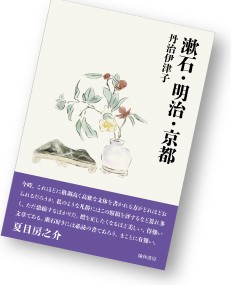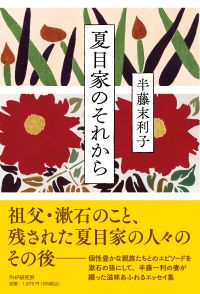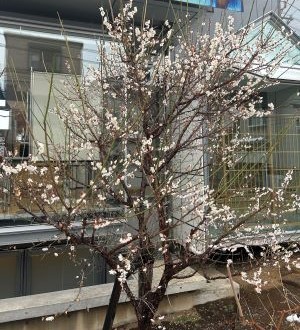吾輩ブログ 一覧
-
関連書籍のご紹介
漱石山房記念館と関係の深いお二方から、夏目漱石に関する書籍が上梓されました。
まず、昨年12月に京都漱石の會代表の丹治伊津子さんの『漱石・明治・京都』。

紙帯で夏目房之介氏が「これほどに格調高く高雅な文体を書かれる方」
と評されていますが、まさにそのとおり。
実際に京都に住んでいるからこその視点で漱石と京都を捉え、
両者に対する愛情と親しみが溢れる内容になっています。
茶道家でもある丹治さんは、京都での夏目漱石顕彰の中心となっている
京都漱石の會を立ち上げ、漱石と京都の魅力を発信し続けています。
漱石山房記念館では、丹治さんの著書やご自身で編集・発行する京都漱石の會会報
「虞美人草」などを寄贈いただいているだけでなく、
夏目漱石の書簡などの貴重な資料も寄せていただき、
記念館の開館以前から長きにわたり支援いただいています。
平成22(2010)年に発行された『夏目漱石の京都』とともに読んでいただくと、
漱石と生涯に4度訪れた京都との所縁について、さらに理解が深まります。
詳しくは下記HP。
http://kanrin.co.jp/book/02_202312_souseki.php
二冊目は、漱石山房記念館名誉館長・半藤末利子さんの『夏目家のそれから』。

半藤名誉館長は、夏目漱石の長女・筆子と漱石門下生で作家の松岡譲の四女。
親族だからこそ知るエピソードが綴られた、夏目家に関するエッセイ集です。
当館の資料の中核となっている「松岡・半藤家資料」は、
同家に残されていた夏目漱石および松岡譲に関する総数900点以上の資料を、
平成29(2017)年に一括して寄贈いただいたものです。
夏目家に関するエピソードを知っていることで、
記念館での展示や資料も広がりや奥行きをもって観覧いただけるのではないでしょうか。
詳しくは下記HP。
https://www.php.co.jp/books/detail.php?isbn=978-4-569-85645-2
今回ご紹介した書籍は、漱石山房記念館の図書室にも配架しています。
ぜひお手に取ってご覧ください。テーマ:お知らせ 2024年2月28日 -
漱石山房の雪景色
寒さのなかにも春の訪れを感じられる頃となりました。
今年の冬は全国的に平年より気温が高い日が続くとの
長期予報が出されたようで、東京もおだやかなお天気が続いていました。そんな中、先日の大雪で、漱石山房にも珍しく雪が積もりました。
こちらは翌朝の漱石公園の様子です。
「猫の墓」の周囲にも雪が積もっています。

日あたりのよい漱石山房の雪は数日ですっかり消えてしまいましたが、
最後に、いまが見ごろに咲いている梅の花をご紹介します。

四季折々の表情がみられる漱石山房にぜひお出かけください。テーマ:その他 2024年2月26日 -
夏目漱石の『文学論』を通して、世界文学を考え直す – 第二部
Rethinking World Literature through Natsume Sōseki’s Theory of Literature
– Part Two
Christopher James GoringFollowing on from the first part, this blog post looks at the relationship
between Natsume Sōseki’s Theory of Literature and the field of comparative literature.
This time round, we will consider how Theory of Literature
can allow us to rethink world literary studies.
According to the work’s preface, Sōseki decided to write Theory of Literature because,
upon comparing English and Chinese literature,
he realised that they ‘must belong to different categories’.
If they ‘belong to different categories’,
then Sōseki’s concept of ‘literature’
– developed based on his experiences with Chinese works –
must not have been universal.
As a result, Sōseki sets out to ‘resolve the more essential question:
What is literature?’ In other words, it is only through the act of cross-border comparison
that Sōseki finds himself able to interrogate the fundamental nature of literature.
In order to express that nature, Sōseki comes up with the formula (F+f).
F refers to the objects that literature depicts, while f refers to the feelings
which come along with such objects or concepts.
While the objects referred to by F and the feelings indicated by f
may vary with the passage of time and between different cultures,
Sōseki argues that ‘literary substance’ is always expressed by this one formula.
I am sure there are many people who consider using mathematical tools
to investigate literary concepts to be overly abstract and,
more to the point, boring.
And yet, from a comparative literary perspective,
there’s lots that’s interesting about Sōseki’s theory.
If we accept Sōseki’s conclusions,
then while the Fs and fs of British and Japanese literature may be different,
they nonetheless share the same underlying substance.
If we compare their Fs and fs, our comparisons may be more effective.
Put another way, thanks to Sōseki’s model we can construct a new framework for comparison.
As a researcher, Sōseki’s non-fiction, just as much as his fiction,
is a treasure trove of interesting concepts.
If you’re interested in getting to know Sōseki a bit better,
why not give Theory of Literature a go?Further Reading:
1.All translations are from Natsume, Sōseki. 2009. Theory of Literature and Other Critical Writings, trans. and ed. by Michael K. Bourdaghs, Atsuko Ueda, and Joseph A. Murphy. Columbia University Press: New Yorkこのブログ投稿の第一部に続き、夏目漱石の『文学論』と比較文学の関係を考えてみます。
今回は、『文学論』の結論を取り入れれば、
世界文学をどう考え直せるかというテーマに移ります。
本の前書きによると、漱石がもともと『文学論』を著した理由は、
中国文学と英国文学を比べたところ、「異種類のもの」であることがわかったからだそうです。
英国文学は中国文学と「異種類のもの」であるということは、
漱石が中国文学に基づいて考え出した「文学」という言葉の定義が普遍的ではなかったということになります。
そこで、漱石は「文学とは如何なるもの」かという問いを解く決心をしました。
つまり、文学の本質(漱石の言う「内容」)を探究できるようになったのは、
中国文学と英国文学を越境した比較のおかげです。
その本質を表現するために、漱石は(F+f)という方程式を作り出しました。
「Fは焦点的印象または概念」、つまり文学が描写するオブジェクトを差す一方、
「fはこれに附着する情緒」、つまりそのオブジェクトや概念に付着している感情を差すということです。
時の経過や文化によって異なるにしろ、
文学の本質はいつもこの方程式に表されていると漱石は主張します。
文学にかかわる概念を追求するのに数学の方程式を使うというのは、
あまりに抽象的で退屈だと考える人が大半なはずです。
しかし、比較文学の観点からすると、漱石の理論は興味深いのではないでしょうか。
漱石の結論を取り入れてみると、英国文学の「F」と「f」は
日本文学のものとは全然違うとしても、両文学には共通した物質があるということになります。
両文学の「F」と「f」を比べることによって、より効果的な比較ができるようになります。
別の言い方をすると、漱石の理論のおかげで、新しい比較的な枠組みを構築することができます。
研究者にとって、漱石の小説はもちろん、そのノンフィクションも面白いコンセプトの宝庫です。
漱石に関する知識を深めるなら、『文学論』を読むことに挑戦してはいかがでしょうか。
(ゴーリング・クリストファー)参考文献
夏目漱石『文学論』岩波文庫、2007年テーマ:漱石について 2024年2月16日 -
夏目漱石の『文学論』を通して、世界文学を考え直す – 第一部
Rethinking World Literature through Natsume Sōseki’s Theory of Literature
– Part One
Christopher James GoringMy name is Christopher Goring and I am an exchange student from the UK
currently residing in Tokyo.
During my Master’s at Oxford, I specialised in comparative literature.
Hoping to expand my research to involve work on the development of the Japanese novel,
I came to Tokyo as a Daiwa Scholar in 2022.
As part of my study aboard programme, I have been completing a work
placement at the Natsume Sōseki Memorial Museum since October last year.
During this work placement, I’ve helped to set up exhibitions,
translated explanations of exhibited items, and helped visitors who do not speak Japanese.
I have also been lucky enough to pursue my own research at the museum.
In addition to Sōseki’s novels and stories, my research also encompasses
Sōseki’s non-fiction essays and critical writing.
In these two blog posts, I would like to take a quick look at his Theory of Literature (Bungaku-ron),
first published in 1907, and its connection to the discipline of comparative literature.
Theory of Literature, edited by Yoshitarō Nakagawa,
had been largely forgotten until recently.
Sōseki himself appears to have been dissatisfied with it.
In the lecture ‘My Individualism’ (‘Watakushi no Kojinshugi’),
Sōseki dismissed Theory of Literature as ‘a deformed corpse’.
Based on the Theory’s preface, he seems to have felt this way
because his intended work was an ‘enormous ten-year project’ which he was unable to bring to fruition.
Even the published version of Theory of Literature was, in many ways, unfinished.
Nevertheless, in recent years, the Theory has been drawing the attention of researchers
in the field of comparative literature.
Take, for example, Michael Bourdaghs, an American scholar of Japanese literature,
who has written a number of essays on Theory of Literature.
He notes that throughout the Theory, Sōseki quotes from English texts
without providing a Japanese translation.
Taking this tendency as his point of departure, Bourdaghs argues that
Sōseki was profoundly sceptical of translation and global literary markets.
Sōseki’s model, however, explores numerous other important concepts in world literary studies.
In the second part, we’ll take a look at a few of them.Further reading:
1.Natsume, Sōseki. 1979. ‘Sōseki on Individualism: “Watakushi no Kojinshugi”’, trans. by Jay Rubin. Monumenta Nipponica, 34.1: 21-48
2.Bourdaghs, Michael. 2021. A Fictional Commons: Natsume Sōseki and the Properties of Modern Literature. Duke University Press: Durhamイギリス出身のゴーリング・クリストファーと申します。
オックスフォード大学院で、比較文学を専攻し、日本の小説の進展を研究対象にして、
2022年に来日しました。留学プログラムの一環として、
去年10月以来、漱石山房記念館で研修をしています。
研修生として、展示の準備、展示品のキャプションの英訳、
外国人来館者の質問へ答えるといった様々な業務に取り組んでいます。
その他に、自分の研究を追求しています。
今行っている研究は漱石の小説を取り扱うのみならず、
随筆、批評を含む彼のノンフィクションも探究しています。
この二部にまたがるブログ投稿では、1907年に出版された『文学論』と
その比較文学への関係を取り上げたいと思います。
中川芳太郎(なかがわよしたろう)により編集された『文学論』は、
一般読者には、最近まで忘れられていました。
漱石自身でさえ『文学論』に不満足だったようです。
『私の個人主義』という講演では、『文学論』を
「畸形児(きけいじ)の亡骸(なきがら)」として退けました。
『文学論』の前書きによれば、『文学論』は完成するのに
「十年」が必要な「大事業」だったということです。
結局、ある意味では、出版された『文学論』のバージョンでさえ
未完成だと考えられます。
しかしながら、近年、比較文学という分野では、
『文学論』は研究者の注目を集めています。
例えば、アメリカ人のマイケル・ボーダッシュという日本文学の研究者は
『文学論』について、いくつかエッセイを出版しました。
漱石がイギリスの作品から引用し、それらの抜粋を和訳せずに
『文学論』に入れる傾向があったということに焦点を合わせています。
その傾向を出発点にし、漱石が翻訳に対しても、世界的な文学市場に対しても
懐疑的だったとボーダッシュは主張します。
しかし、漱石の構築した理論は、世界文学にかかわる他の概念についても様々に探究していると
私は考えます。
第二部では、そのコンセプトの中から、いくつか取り上げたいと思います。
※本文中には今日では不適切と思われる語句が見られますが、当時の表記を尊重し、そのままとしました。参考文献
夏目漱石「私の個人主義」三好行雄編『漱石文明論集』 岩波書店、1986年,p.97-138
夏目漱石『文学論』岩波文庫、2007年
マイケル・ボーダッシュ「夏目漱石の「世界文学」―英語圏から『文学論』を読み直す」『文学』2012年 Vol.13, no.3. p.2-16.テーマ:漱石について 2024年2月9日

